Hands-on With Re: HTC's New Periscope-Like Mini Camera
It's a periscope! It's a rescue inhaler! It's a... camera?
 Credit:
Credit:
Products are chosen independently by our editors. Purchases made through our links may earn us a commission.
A few months ago, HTC announced plans to enter the photography market. The Re (MSRP $199.99) camera is unlike just about any other camera you can buy. It's not quite a GoPro, but it's certainly not edging up against compact point-and-shoot cameras either. It has WiFi, but you don't need a phone to use it.
Not only does the Re avoid aping any of its de facto competition, it's designed unlike any camera we've ever seen. We're not quite sure what to compare it to, because it's somewhere between a cartoon asthma inhaler and the periscope on an adorable toy submarine.
But after spending some time with the camera, we were pleasantly surprised by how well it works. While it's not anywhere near the experience you'd get from a traditional point-and-shoot, it never really promised that in the first place. From the moment you pick it up, the Re gives you a very different experience from either a smartphone or a point-and-shoot.
Shooting Experience
Shooting without any kind of viewfinder is a pretty strange experience. The universal symbol for "camera" often involves someone holding a camera up to their face—something that won't work when you're shooting with the Re. And even though you can power up the Re app on iOS or Android to let you control the camera, it's impractical to hold a phone in one hand and the Re in the other just to frame your shots.
One of our favorite things about the Re is the fact that it lacks any kind of power button. We wish more cameras were this smart. You don't have to wait for a lens to open or for the camera to wake up—simply hold it in your hand and it'll be ready to shoot.
{{ photo_gallery "sample" }}
Once you get over the unique form factor of the Re, one thing becomes readily apparent: The lens is wider than you think it is. Even seasoned street photographers used to shooting with wide angle lenses will find the Re's ultra-wide 146-degree angle of view difficult to adapt to.
With no viewfinder, the upside is obviously that if your subject is more or less in front of you then you'll get a usable photo. The downside is that such a wide-angle lens comes with tons of optical aberrations, including loads of distortion. You can fit plenty of people in the frame, for example, but if you're shooting from the wrong angle you'll be left with some rather unflattering portraits.
{{ photo_gallery "wide" }}
The lens also has a fixed focus lens to go along with a fixed f/2.8 aperture, which sounds almost fast enough for low-light shooting. But, in our experience, this yielded less-than-stellar results.
The star of the show is the Re's Sony-sourced 16-megapixel, 1/2.3" sensor. It's the same standard size as a sensor in an average point-and-shoot camera. Even though the Re isn't quite as rough-and-tumble as a GoPro (it's IPX7-rated to be somewhat waterproof on its own but that's about it), this is the same sensor type we've seen in the last few generations of Hero Black Edition cameras. Beware that when you boot up the Re for the first time, its default shooting mode is a 16:9, 12-megapixel crop. To get the 16-megapixel experience, switch to the full-res 4:3 mode.
Connectivity
Since you don't have a screen to quickly preview what photos you've nabbed, it's a bit of a trick making sure your shots have turned out all right. With its built-in WiFi and Bluetooth, the Re makes a good partner for your Android or iOS smartphone. Due to its lack of controls, Re moves most of its advanced functions to the phone app.
One of the more interesting features is the fully automated time-lapse functionality. You can set the timer for the time span and the frequency of images, and the Re compresses the photos into a 30 fps MP4 movie clip. Check out our sample footage below.
Downloading photos from the Re is pretty fast and painless, too. There's an automatic function that pushes photos from Re to your phone as a backup for as long as the two are connected. Photos are also stored on a micro SD card that the RE includes, stored underneath a tiny flap on the camera's round base. You can even plug the Re directly into a computer using micro USB to grab photos off the camera.
Shortcomings
Our biggest problem with the Re is undoubtedly its lack of autofocus. Given the absence of a display, we understand why there isn't any, but it's easy to get sharper shots and nice subject separation from a smartphone camera, the vast majority of which have autofocus these days. It's made worse by the slow shot-to-shot speed, something we didn't expect from such a minimal camera.

Low-light image quality is pretty terrible.
We were also very disappointed at how noisy and blurry low-light images appear. Even though it rocks a wide aperture and a big sensor, the Re can't keep up with most modern smartphones in low-light. Maybe with optical image stabilization it could be a decent contender in this area, but as it stands, phones like the iPhone 6 Plus or Nokia Lumia 1520 can eat Re's lunch in a dim room.
Video wasn't compelling either, exhibiting some rolling shutter. We think you might be better off just using your smartphone if you want to capture HD footage. It's nice that it shoots 1080/60p video, and the option for 120 fps at 720p is cool, but phones like the iPhone 6 can already pull this trick off with relative ease.
Another major issue was how we connected to the Re using an app on an Android device. The camera wouldn't connect until after a number of resets, Bluetooth and WiFi toggles, and app reinstalls. Funnily enough, for a company that makes Android phones, it's clear HTC has a ways to go regarding quick and easy connections. On iOS, the experience was a bit easier, but you'll need to manually connect to your Re before starting the app. The iOS app even checked for an update to Re and installed it in a matter of minutes. Though neither experience was seamless, the iOS one was markedly easier.
And unfortunately—though perhaps not unexpectedly—there's no app at all for Windows-based phones and tablets, even though HTC makes several Windows Phone handsets.
Is it worth $199?
Like a lot of dedicated cameras, it's a firm, "maybe" depending on your circumstances. If you're in the market for a GoPro, and the low-end 2014 Hero is too bare bones for you, then Re could be a viable alternative. You won't get the rugged credentials (or accessory compatibility) of the GoPro cameras, but it has the connectivity that the barebones 2014 Hero doesn't have, for only about $75 more.
If we had to categorize the Re, we'd have to put it down as a funky successor to pocket camcorders like the Flip HD and Kodak Zi8 that were popular pre-GoPro. To that end, if you're looking for a dedicated camera/camcorder that's substantially better than your smartphone then you should look elsewhere. The Re line may someday boast the kind of image quality that'll make you leave your phone in your pocket, but it's got a long way to go.
